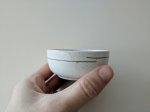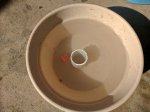You are using an out of date browser. It may not display this or other websites correctly.
You should upgrade or use an alternative browser.
You should upgrade or use an alternative browser.
From Tea to Tree in 5 minutes
- Thread starter bonsaidave
- Start date
-
- Tags
- diy
Random User
Guest
- Messages
- 1,313
- Reaction score
- 1,170
I have a high speed 1/4" die grinder and some carbide bits that I use to do the same thing on terra cotta and pottery of all kinds. I find, if I go from each side a little at a time it prevents the break out on the exiting side. For the most part this is cosmetic, but I follow the general rule of physics that says a smooth hole won't encourage cracking... like drilling a "stop crack hole" on the end of a crack in a piece of metal. I have no way to prove that it's effective, but I do it anyway.
Nice pot.
Nice pot.
Smoke
Ignore-Amus
Why not just buy a pot with a hole already in it?
Random User
Guest
- Messages
- 1,313
- Reaction score
- 1,170
I find that some of the best pots weren't meant for plants... like ordinary pottery that was spun on a wheel.
Out here in the sticks, we don't have bonsai "friendly" pots in particular... it just isn't something that people readily do, so it becomes a supply and demand factor. Shallow pots are unheard of as a general rule, so I modify whatever I think will work and what suits my eye... even if it's an old porcelain pi$$ pot...
Out here in the sticks, we don't have bonsai "friendly" pots in particular... it just isn't something that people readily do, so it becomes a supply and demand factor. Shallow pots are unheard of as a general rule, so I modify whatever I think will work and what suits my eye... even if it's an old porcelain pi$$ pot...
bonsaidave
Shohin
M. Frary
Bonsai Godzilla
I live in the "sticks" also.I find that some of the best pots weren't meant for plants... like ordinary pottery that was spun on a wheel.
Out here in the sticks, we don't have bonsai "friendly" pots in particular... it just isn't something that people readily do, so it becomes a supply and demand factor. Shallow pots are unheard of as a general rule, so I modify whatever I think will work and what suits my eye... even if it's an old porcelain pi$$ pot...
The Google function on this smartphone finds all kinds of pots with holes in them already.
bonsaidave
Shohin
"Why not just buy a pot with a hole already in it?"
I found a couple people mention drilling holes in bowls elsware online. I thought I would give it a try just to see if it was at all feasible. I must say everything I have drilled was surprisingly stout with nothing cracked yet. Hard to beat a buck fifty for a mini pot.
Successful experiment !
I found a couple people mention drilling holes in bowls elsware online. I thought I would give it a try just to see if it was at all feasible. I must say everything I have drilled was surprisingly stout with nothing cracked yet. Hard to beat a buck fifty for a mini pot.
Successful experiment !
Anthony
Imperial Masterpiece
Let me know when you start looking at Little Girls' tea sets.
Or testing tiny cactus pots.
You can find lots of interesting containers, with some imagination.
More power to you, Dave.
Good Xmas
Anthony
Or testing tiny cactus pots.
You can find lots of interesting containers, with some imagination.
More power to you, Dave.
Good Xmas
Anthony
Smoke
Ignore-Amus
Hard to beat a buck fifty !
There it is......
M. Frary
Bonsai Godzilla
You guys going to have a party?Let me know when you start looking at Little Girls' tea sets.
Anthony
Imperial Masterpiece
Yup Gogee,
wanna bring the crumpets [ crumpled bodies ]


wanna bring the crumpets [ crumpled bodies ]
defra
Masterpiece
Cool project only there are no spaces beneath the pots for the air to go trough and water cant get out properly
how you going to resolve that?
how you going to resolve that?
Dav4
Drop Branch Murphy
- Messages
- 13,635
- Reaction score
- 33,232
- USDA Zone
- 6a
Wiring the tree into the pot will cause the pot to wobble because it'll be sitting on the wireCool project only there are no spaces beneath the pots for the air to go trough and water cant get out properly
how you going to resolve that?
BadgerBadger
Seedling
If you're going to drill pottery and ceramics just soak it in water for a day or two first.
Then take it out and drill with the appropriate drill bit and whammy!
Then take it out and drill with the appropriate drill bit and whammy!
defra
Masterpiece
Wiring the tree into the pot will cause the pot to wobble because it'll be sitting on the wire
clever !
i tought buy a similair pot smash it and glue some pieces on it as feets lol
bonsaidave
Shohin
M. Frary & Anthony, you have the tea party with crumpets first and then you ruin the tea cups after 
Wire on some of them would be an issue. Maybe making a circle on the bottom, with the wire, could fix this. Half of these had a small lip on the bottom so wire should fit fine on those.
These are also small enough to where they would be placed half way down into a tray filled with pebbles. Would illuminate any wire issue, water/air issue, help to keep them stable, and keep soil damp longer (I think).
BadgerBadger, Soaking the pots? Interesting idea. I will have to test that next time.
defra, Nice idea with gluing small smashed pot bits to the bottoms. Or big bits to make them look very silly.
Wire on some of them would be an issue. Maybe making a circle on the bottom, with the wire, could fix this. Half of these had a small lip on the bottom so wire should fit fine on those.
These are also small enough to where they would be placed half way down into a tray filled with pebbles. Would illuminate any wire issue, water/air issue, help to keep them stable, and keep soil damp longer (I think).
BadgerBadger, Soaking the pots? Interesting idea. I will have to test that next time.
defra, Nice idea with gluing small smashed pot bits to the bottoms. Or big bits to make them look very silly.
Random User
Guest
- Messages
- 1,313
- Reaction score
- 1,170
If there is a ring on the underside of the pot, I use an angle grinder with a 80 grit flapper disc to grind 4 slots in the rim for water to flow out of... it's no biggie. Unlike the process you guys use, I don't "drill" holes, I use "industrial grade, 1/4" drive, carbide grinding bits intended for steel"... but I do also employ a little water, to keep the dust down and the pottery cool while grinding the majority of it... works good.
bonsaidave
Shohin
Just found one of my $1.50 diy pots on an Australian bonsai site. They want 16.95AUD for drilling 4 holes. 
http://www.bonsaiwarehouse.com.au/s...-wedge-glazed-unglazed-round-mame-bonsai-pot/
http://www.bonsaiwarehouse.com.au/s...-wedge-glazed-unglazed-round-mame-bonsai-pot/
Similar threads
- Replies
- 3
- Views
- 352







